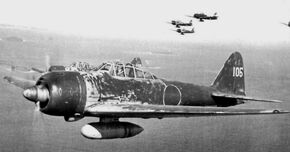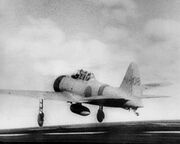The A6M Rei-Sen or "Zero" was a single-seat, fighter aircraft that was used by Japan during WWII.
Description[]
The name "Zero" comes from the official designation, the Type 0 Carrier Fighter. The first production model of the A6M series was the A6M2, which had a 950 hp, Nakajima Sakae 12 Engine capable of propelling the "Zero" at speeds of up to 533 km/h. The A6M had an armament of two Type 99 20mm guns mounted in the wings and two 7.7mm MGs mounted in the nose. The Zero could also be equipped with two 60 kg bombs.[1] 15 pre production examples were deployed to China with the 12th Air Group Fighter Squadron.[2]
One of the reasons the Zero was so fast was the fact that in had practically no armor, with only a thin sheet of metal separating the pilot from the air around him. This thin armor was later exploited by Allied pilots such as the Flying Tigers. Another weakness was that most examples of the Zero had no self-sealing fuel tanks, so when it was hit, it ignited into a large fireball.
Reinforcement of the rear wing spar was introduced on the 22nd A6M2. Designation changed from Model 11 to Model 21 following incorporation on folding wingtips from the 65th example. New aileron balance tabs introduced from the 127th aircraft. Installation of a 1,130 hp Sakae 21 with two stage supercharger in the following version, the A6M3, made it necessary to move the firewall aft by 20.3 cm (8 in), resulting in capacity of the fuselage fuel being reduced from 98 litres (21.6 Imp Gal) to 60 Litres (13.2 Imp Gal). Fuel consumption was much higher than before. The folding wingtips were removed – leading to allocation of a new ID code – and bringing a slight improvement in high speed agility. Ammunition capacity for the 20mm guns was increased from 60 to 100 rounds. There were also 560 examples of the longer ranged Model 22, fitted with a 45-litre (9.9 Imp Gal) fuel tank outboard of the cannon bay in each wing and which had the folding wingtips restored.[2]
Variants[]
The first variant of the A6M Zero series was the A6M2-K, an advanced two seat trainer conversion completed in November 1943, with the 20mm cannon removed. The next variant was the Nakajima A6M2-N which was fundamentally a floatplane variant of the Zero built by Nakajima, and intended for operation from water bases among Pacific atolls. It was known to the allies as "Rufe". Following came the A6M3 Model 32 which had introduced square wingtips, lesser weight due to lesser fuel and a larger engine. Also produced alongside it were the A6M3 Model 22 and 22a.

An A6M3 Model 22 Zero in the Soloman Islands
Both of which had folding wings and additional fuel, though the 22a had lengthend 20mm autocannons. After the failure of the A6M4 with a super charged engine, the A6M5 Model 53 was introduced. It was a modified A6M3 designed to have a higher safe diving speed by use of a wing with heavier gauge skin. Furthermore, it had rounded wingtips restored and folding wings removed. The A6M5, similarly to the A6M3, also had several sub models. In this case, these were the Models 52a, 52b, and 52c also known as the Ko, Otsu, and Hei. The A6M5 Ko being the first model, with the Otsu and Hei coming next. The Otsu was one of the first Zeros to break the misconception of lightly armored Japanese planes by introducing increased armor for the pilot, a fire extinguisher mechanism, and bullet proof glass.
Also Importantly, the type had an increased armament and had the option of carrying two additional drop tanks. The Hei type meanwhile had added a self-sealing fuel tank and additional armor all around the cockpit, though the tank located just behind the pilot created center of gravity issues.
Following the Model 52 series was the Model 22 A6M5 which had thicker skin for faster diving, improved flaps, and long barrel autocannons. Also produced was the A6M5K, a very limited production run of advanced trainer aircraft.The final variants of the A6M series were the A6M6, A6M7, and A6M8 along with their sub-variants, all of which were more last-ditch efforts to improve upon the zero. Due to the increased bombing on Japan, few to none of these models were produced.

An A6M2 Zero taking off for the attack on Pearl Harbor
History[]
The A6M Zero was initially produced in 1939 following a 1937 order for a new carrier based fighter, with the first example taking flight in 1940 as the A6M1. These models were so successful that they were rushed into service in China before entering actual production.[3] Here the planes excelled, earning legendary status in a few months. Most western designers refused to believe a plane of such excellence even existed, causing the United States to be greatly setback at the onset of the conflict. However, once the weaknesses of the Zero were exploited in such tactics as the Thatch Weave, the figurative playing field became level.[4] Furthermore, after the capture of the Akutan Zero in the Aleutian Islands, Allied planes could finally become true equals in terms of plane design and combat effectiveness. This in turn created such desperation that tactics such as Aerial Ramming and Kamikaze attacks were widespread. By the war's end, some 10,000 zeros of various makes and models had been produced.
References[]
- ↑ http://www.wwiivehicles.com/japan/aircraft/fighter/mitsubishi-a6m2-zero.asp
- ↑ 2.0 2.1 Jackson, Robert. Combat Legend Mitsubishi Zero. Airlife. 2003.
- ↑ Lüdeke Alexander. Weapons of World War II. Parragon Publishing (2007), Page 222
- ↑ Young M. Edward. F4F Wildcat vs A6M Zero-Sen. Osprey Publishing (2013), Page 53
| |||||||||||||||||
